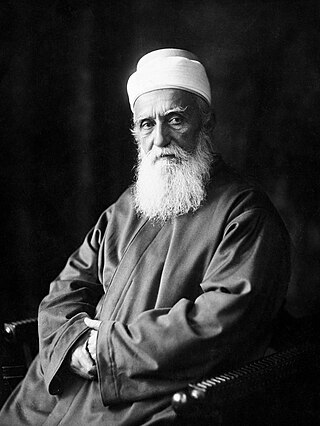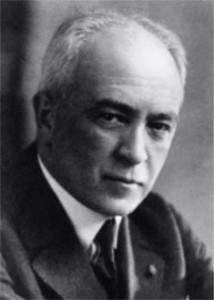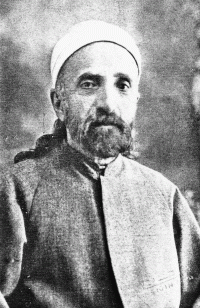Bahai may refer to:

ʻAbdu'l-Bahá, born ʻAbbás, was the eldest son of Baháʼu'lláh and served as head of the Baháʼí Faith from 1892 until 1921. ʻAbdu'l-Bahá was later canonized as the last of three "central figures" of the religion, along with Baháʼu'lláh and the Báb, and his writings and authenticated talks are regarded as sources of Baháʼí sacred literature.

The Baháʼí Faith is a religion founded in the 19th century that teaches the essential worth of all religions and the unity of all people. Established by Baháʼu'lláh, it initially developed in Qajar Iran and parts of the Middle East, where it has faced ongoing persecution since its inception. The religion is estimated to have 5 to 8 million adherents, known as Baháʼís, spread throughout most of the world's countries and territories.

Charles Mason Remey was a prominent member of the early American Baháʼí community, and served in several important administrative capacities. He is well-known for an attempted schism of 1960, in which he claimed leadership and was rejected by the overwhelming majority of Baháʼís, who regard him as a Covenant-breaker.

Shoghí Effendi (; 1 March 1897 – 4 November 1957) was the grandson and successor of ʻAbdu'l-Bahá, appointed to the role of Guardian of the Baháʼí Faith from 1921 until his death in 1957. He created a series of teaching plans that oversaw the expansion of the faith to many new countries, and also translated many of the writings of the Baháʼí central figures. He was succeeded by an interim arrangement of the Hands of the Cause until the election of the Universal House of Justice in 1963.

Mírzá Muhammad ʻAlí was one of the sons of Baháʼu'lláh, the founder of the Baháʼí Faith. He was the eldest son of his father's second wife, Fatimih Khanum, later known as Mahd-i-'Ulya, whom Baháʼu'lláh married in Tehran in 1849. Muhammad ʻAlí received the title from his father of G͟husn-i-Akbar.

The Shrine of the Báb is a structure on the slopes of Mount Carmel in Haifa, Israel, where the remains of the Báb, founder of the Bábí Faith and forerunner of Baháʼu'lláh in the Baháʼí Faith, are buried; it is considered to be the second holiest place on Earth for Baháʼís, after the Shrine of Baháʼu'lláh in Acre. Its precise location on Mount Carmel was designated by Baháʼu'lláh himself to his eldest son, ʻAbdu'l-Bahá, in 1891. ʻAbdu'l-Bahá planned the structure, which was designed and completed several years later by his grandson, Shoghi Effendi.

The Baháʼí Terraces, or the Hanging Gardens of Haifa, are garden terraces on Mount Carmel in Haifa, and one of the most popular tourist destinations in Israel. Completed in 2001, there are 19 terraces and more than 1,500 steps ascending the mountain. The central terrace has the Shrine of the Báb, one of the main religious sites of the Baháʼí Faith. The architect was Fariborz Sahba from Iran, and the structural engineers were Karban and Co. from Haifa.

The Baháʼí World Centre buildings are buildings that are part of the Baháʼí World Centre in Israel. The Baháʼí World Centre buildings include both the Baháʼí holy places used for pilgrimage and the international administrative bodies of the Baháʼí Faith; they comprise more than 20 different administrative offices, pilgrim buildings, libraries, archives, historical residences, and shrines. These structures are all set amidst more than 30 different gardens or individual terraces.

Shaykh Ahmad bin Zayn al-Dín bin Ibráhím al-Ahsá'í, commonly known as Shaykh Ahmad or al-Ahsá'í, was a prominent Shia Muslim theologian and jurist who founded the influential Shaykhí school of Twelver Shiism, which attracted followers from throughout the Persian and Ottoman Empires.
The Baháʼí Faith has its background in two earlier movements in the nineteenth century, Shaykhism and Bábism. Shaykhism centred on theosophical doctrines and many Shaykhis expected the return of the hidden Twelfth Imam. Many Shaykhis joined the messianic Bábí movement in the 1840s where the Báb proclaimed himself to be the return of the hidden Imam. As the Bábí movement spread in Iran, violence broke out between the ruling Shiʿa Muslim government and the Bábís, and ebbed when government troops massacred them, and executed the Báb in 1850.
Shaykhism is a Shi'a Islamic school founded by Shaykh Ahmad in early 19th-century Qajar Iran. While grounded in traditional Twelver Shiʻi doctrine, Shaykhism diverged from the Usuli school in its interpretation of key ideas such as the nature of the end times and the day of resurrection, the source of jurisprudential authority, and the proper hermeneutic to be employed in interpreting prophecy through the mystical writings of the Twelver Imams. These divergences resulted in controversy and ongoing accusations of heresy from Usulis and Akhbaris.
Baháʼí literature covers a variety of topics and forms, including scripture and inspiration, interpretation, history and biography, introduction and study materials, and apologia. Sometimes considerable overlap between these forms can be observed in a particular text.
The Shrine of ʻAbdu'l-Bahá is the location in Israel wherein the remains of ʻAbdu'l-Bahá, one of the central figures of the Baháʼí Faith, will be interred. Since his death in 1921, ʻAbdu'l-Bahá's remains have been located beneath one of the rooms of the Shrine of the Báb in Haifa, Israel.
The writings of Baháʼu'lláh are the corpus of texts written or narrated by Baháʼu'lláh, which are regarded as sacred scripture in the Baháʼí Faith. Baháʼu'lláh was the founder of the Baháʼí Faith; he was born in Persia and later exiled for being a follower of the Báb, who in 1844 had declared himself to be a Manifestation of God and forerunner of "Him Whom God shall make manifest". Bahá’ú’lláh first announced his claim to be a Manifestation of God in 1863 and spent the rest of his life as a prisoner of the Ottoman Empire, exiled first to Baghdad, followed by Istanbul, Edirne, where he began proclaiming his mission, and finally Acre. His teachings revolve around the principles of unity and religious renewal, ranging from moral and spiritual progress to world governance.
The Baháʼí Faith originated in the 19th century Persian empire, and soon spread into the neighboring British India, which is now Pakistan and other states. The roots of the religion in Pakistan go back to the 1840s, and it was recognized in the constitution of 1981 as a religious minority with legal rights. According to various sources, there are 2,000 to 87,000 Baha'is living in Pakistan.

The Baháʼí Faith in Egypt has existed for over 150 years. The first followers of the Baháʼí Faith arrived in Egypt in 1863. Baháʼu'lláh, founder of the religion, was himself briefly in Egypt in 1868 when on his way to imprisonment in ʻAkká. The first Egyptians were converts by 1896. Despite forming an early Baháʼí Local Spiritual Assembly and forming a National Assembly, in 1960 following a regime change the Baháʼís lost all rights as an organised religious community by Decree 263 at the decree of then-President Gamal Abdel Nasser. However, in 1963, there were still seven organized communities in Egypt. More recently the roughly 2000 or 7000 by ARDA Baháʼís of Egypt have been embroiled in the Egyptian identification card controversy from 2006 through 2009. There have been homes burned down and families driven out of towns.
The Baháʼí Faith was first introduced in China during the lifetime of its founder, Baháʼu'lláh (1817–1892).

The Baháʼí World Centre is the name given to the spiritual and administrative centre of the Baháʼí Faith, representing sites in or near the cities of Acre and Haifa, Israel.
The Baháʼí Faith (بهائی) has a following of at least several hundred people in Lebanon dating back to 1870. The community includes around 400 people, with a centre in Beit Mery, just outside the capital Beirut, and cemeteries in Machgara and Khaldeh. On the other hand, the Association of Religion Data Archives estimated some 3,900 Baháʼís in 2005.

Euphemia Eleanor Baker (1880–1968) was an Australian photographer, and follower and advocate of Baháʼí Faith. Initially she took pictures of Australian wildflowers and published them in a booklet form. Later, after becoming a follower of Baháʼí Faith in 1922, she took pictures of the Baháʼí monuments in Australia, New Zealand, Iraq and Persia, some of which were included in Shoghi Effendi's translation of the book The Dawn-Breakers. She became one of the Baháʼí Faith's notable photographers.